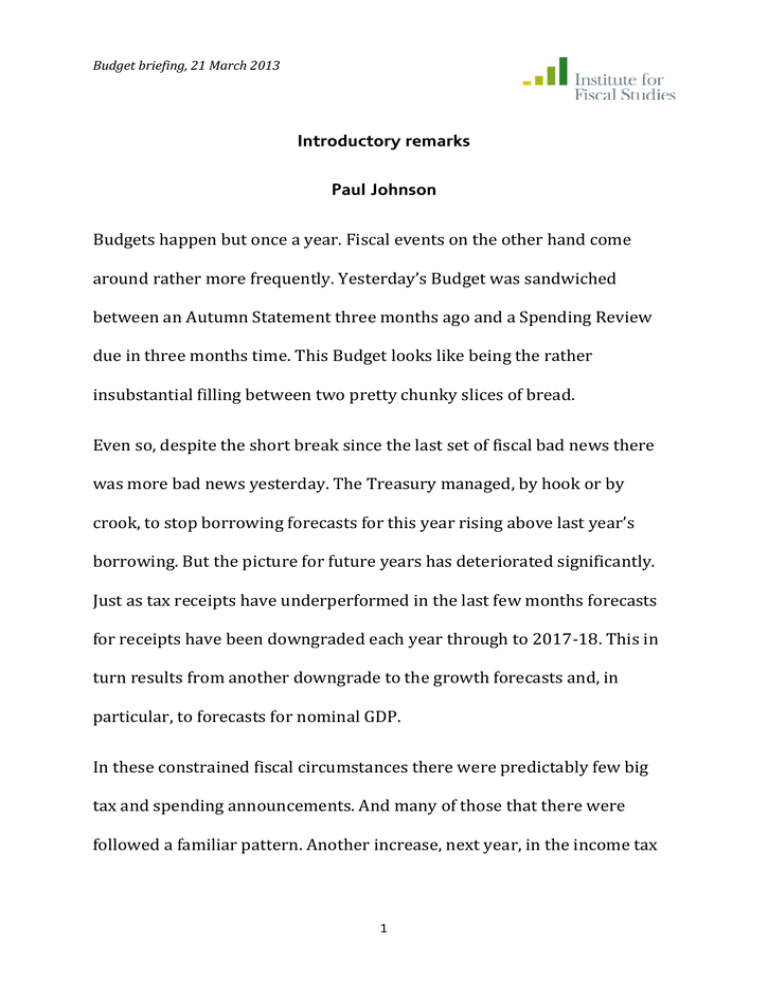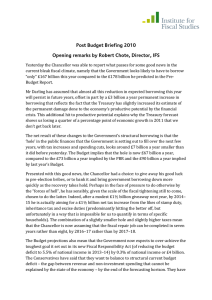Introductory remarks Paul Johnson around rather more frequently. Yesterday’s Budget was sandwiched
advertisement

Budget briefing, 21 March 2013 Introductory remarks Paul Johnson Budgets happen but once a year. Fiscal events on the other hand come around rather more frequently. Yesterday’s Budget was sandwiched between an Autumn Statement three months ago and a Spending Review due in three months time. This Budget looks like being the rather insubstantial filling between two pretty chunky slices of bread. Even so, despite the short break since the last set of fiscal bad news there was more bad news yesterday. The Treasury managed, by hook or by crook, to stop borrowing forecasts for this year rising above last year’s borrowing. But the picture for future years has deteriorated significantly. Just as tax receipts have underperformed in the last few months forecasts for receipts have been downgraded each year through to 2017-18. This in turn results from another downgrade to the growth forecasts and, in particular, to forecasts for nominal GDP. In these constrained fiscal circumstances there were predictably few big tax and spending announcements. And many of those that there were followed a familiar pattern. Another increase, next year, in the income tax 1 Budget briefing, 21 March 2013 personal allowance. The cancelling of yet another increase in fuel duties. Another cut in the main rate of corporation tax. Partly as a result of these tax cuts yesterday’s announcements amount to a modest fiscal loosening in 2014-15 and 2015-16. In the scorecard we then see this loosening partly offset by a modest tightening in the subsequent two years. But this is an odd kind of tightening. It is driven by increased National Insurance revenues from public sector employers. The implication is that the real effect of public spending cuts pencilled in for the next parliament will be even more severe than expected hitherto. Add to that the fact that we are promised more capital spending, more spending on social care, and a more generous childcare subsidy, within an overall spending envelope that has not been expanded and the outlook for all other unprotected spending looks grim indeed. We also see in the Budget though confirmation of some of this government’s reforming tendencies. The eventual £11 billion a year investment in raising the personal income tax allowance is a big tax reform consistently pursued and tax rates on companies are being brought decisively downwards. Bringing forward the new flat rate pension by a year may have been driven as much by a consideration of additional 2 Budget briefing, 21 March 2013 National Insurance revenues it will bring in as by any zeal to spread the benefits of the new pension more quickly, but the reform itself is a welcome and long overdue simplification to the pension system. The proposed changes to childcare support are broadly positive. The housing policy changes, in particular the “help to buy” mortgage guarantee scheme, represent radical interventions in the housing market. Turning to the Public finances To the surprise of many the Chancellor was still able to say that he hopes to bring borrowing in this year below last year’s total – though with literally the smallest possible headroom when measured on a like for like basis. How has he managed that feat in the face of tax receipts coming in £5 billion less than forecast in December? The answer is by squeezing Whitehall spending hard in February and March this year. Some of this underspend is permanent but some of it has been managed into next year including, in the words of the OBR “money that the Treasury has agreed to allow departments to move into future years” and “payments that were due to be made late in the current financial year, but which are being delayed into 2013-14”. There is every indication that the numbers have been carefully managed with a close eye on the headline borrowing figures for 3 Budget briefing, 21 March 2013 this year. It is unlikely that this has led either to an economically optimal allocation of spending across years or to a good use of time by officials and ministers. The truth is that borrowing is the same this year as it was last year. And it will be the same next year as this year. Because of that, this year’s precedent suggests that there must be a risk that effort will be expended again next year to shift spending into 2014-15. All this is desperately disappointing for a Chancellor focussed on reducing the deficit. Some sense of how disappointing is illustrated by two sets of numbers. 121, 120, 108. 89, 60, 37. The first three numbers are borrowing in pounds billion expected this year, next year and in 2014-15. The second three numbers were the forecasts for the same years made at the time of the June 2010 Budget. The Chancellor now looks like he will be borrowing £70 billion more in 2014-15 than he had originally hoped. Small additional spending cuts in 2013-14 imply a slight fiscal tightening next year. But the fall in spending this year means that overall departmental expenditure limits are not actually going to fall any further in real terms over the next two years. Year on year real cuts in departmental spending have effectively come to end for the period of this parliament. 4 Budget briefing, 21 March 2013 Mr Osborne has actually decided to loosen the purse strings a little in 201415 and 2015-16. A £3 billion net tax cut in 2015-16 has not been offset at all. The numbers for 2016-17 and 2017-18 are then rather flattered by scoring the additional NI revenues from public sector employers. Unless the spending envelope for these years is loosened this will imply a cut in real resources going to public services. There are other changes too which might frighten Whitehall departments. While the overall spending envelope has not been increased since the eye wateringly tight one implied by the Autumn Statement, nearly £5 billion of additional spending on capital, childcare and social care has been committed to. That leaves even less for everything else. Whitehall departments might take some encouragement though from one rather heavy hint dropped in the Red Book. “Fiscal consolidation for 201617 and 2017-18 is expressed as a reduction in TME. It would, of course, be possible to do more of this further consolidation through tax instead”. Indeed. Such an outcome looks more likely than not. So what about those tax cuts? Despite the straitened fiscal circumstances Mr Osborne managed to announce four significant tax cuts – and a cut in beer duty. 5 Budget briefing, 21 March 2013 Three of these cuts were very much continuations on a familiar theme – a further increase in the income tax personal allowance, yet another cancellation of increase in fuel duties, and a further cut to rate of corporation tax. Add together all the cost of all the changes to these taxes since 2010 – including the cost of abolishing the fuel duty escalator – and the Chancellor will be spending a pretty remarkable £24 billion a year on these changes by 2016-17. That would be a big investment at any time. In the current fiscal climate this is a striking investment in a narrow range of priority areas. It’s a combined tax cut worth nearly double the amount raised by the rather painful increase in the main rate of VAT to 20% in 2011. The biggest of these investments – at nearly £11 billion in 2016-17 – is in the increase in the personal tax allowance. The Chancellor will also be bringing in £5 billion less fuel duty revenue than he might have done had he continued with the duty escalator. Between them these changes help explain why basic rate taxpayers, middle earners – those in the upper middle part of the overall income distribution – have been least squeezed by the tax and benefit changes implemented as part of the fiscal consolidation. Poorer households have been hit harder by benefit cuts. 6 Budget briefing, 21 March 2013 Higher rate taxpayers, and especially richer higher rate taxpayers, have seen their tax bills rise quite sharply. In terms of effects on household budgets this year yesterday’s announcements were something of a non-event. But don’t forget that there are some substantial benefit cuts happening in April and some tax cuts too. What of the really new tax policy – the introduction of a £2,000 Employment Allowance for employers National Insurance Contributions? As with any such change it has the potential to complicate the tax system, but it does look like it might be quite tightly targeted in two senses. First, most of the benefit will go to small employers. The cost is kept down because it is worth so little to large employers where the majority of people work. Second, relative to a straightforward cut in employer National Insurance Contributions it seems more likely that the incidence will be on the employer – it will be employers rather than their existing employees who benefit. Whether it will actually have any measurable effect on job creation we don’t know. Given that it won’t be piloted and will be almost impossible to evaluate the sad truth is we are likely never to know whether this will be money well spent. 7 Budget briefing, 21 March 2013 The Chancellor made rather a lot of one final tax change – the cut in duty on beer and the abolition of the alcohol duty escalator from next year. In light of the decision not to implement minimum pricing for alcoholic drinks a more imaginative response to a problem of excess drinking, which the government does seem to acknowledge, might have been welcome. As we showed in a paper published earlier this week, (http://www.ifs.org.uk/bns/bn138.pdf) there is plenty of scope to rationalise the system of excise duties on alcohol so as to target heavy drinkers – who tend to drink higher strength and less highly taxed forms of alcohol. Reforms could be designed which would have a more direct effect on problem drinking than would a minimum price and which would raise revenue for the Exchequer – rather than provide a windfall for the drinks industry which is what a minimum price would achieve. Let me conclude. And hand over to my colleagues who I hope will shed at least some light on the rather impenetrable undergrowth of this year’s Budget. 8

